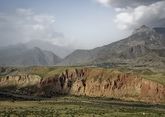At the beginning of next year, China will start to develop another gold ore field in Tajikistan's Sughd Province, official representative of the Tajik Aluminium Company TALCO Igor Sattarov said. According to him, the project was offered to companies in Russia and other countries, but China’s Tibet Huayu Mining Co Ltd showed the greatest interest. Dushanbe places its subsoil under control of Chinese companies in exchange for investment and in settlement of debts.
More than 80% of gold in Tajikistan is mined by joint with China ventures. There are about 40 existing and promising gold mines in Tajikistan with deposits estimated at 400 tons. According to the World Gold Council, Tajikistan's gold reserve as of February 2018 was 15.6 tonnes. At the beginning of 2010, the country's gold reserves were 2.6 tonnes, and back in 2000 - only 200 kilograms. Tajikistan takes the 63rd place on a global scale in terms of its gold reserves.. Even despite the fact that only 14 fields are being developed.
Gold ore fields are mostly developed by joint Tajik-Chinese companies. But there are exceptions in which 100% of the shares belong to China. Tajikistan's biggest gold producer is the Zaravshon joint venture. This year alone, it produced 73% of the gold extracted in the country. Another 13% was produced by China's Pakrut and 5.4% by the Aprelevka joint venture. 4.9% - accounted for the Tilloi Tochik state enterprise. The rest of the gold comes from small enterprises and artels, Minister of Industry and New Technologies Zarobiddin Fayzullozoda said. In total, according to him, this year the republic increased gold production by 54%, which amounted to 3.8 tons.
Next year, Dushanbe plans to reach record gold production levels through the development of a new Konchoch deposit located in Sughd Province of Tajikistan. Its gold reserves are estimated at 55 tons, silver reserves - at about 44 tons. In addition, the deposit also has reserves of mercury (184 tons), antimony (268,000 tons), fluorite (205,000 tons) and a number of other minerals, which will also be mined there.
The mine will be developed by TALCO Gold, jointly owned by the Tajik Aluminium Company TALCO and the Chinese company Tibet Huayu Mining Co., each of them has a 50% stake in the charter capital of the company. China's total investment in the project exceeds $200 million. They promise to start processing metals next year. Talco Gold spokesman Zhou Wu said that they had already drawn high-voltage lines and dug tunnels. Their plans include the construction of a dam and a drainage channel, as well as a tailing pond, the Current Time reported.
According to Igor Sattarov, TALKO Gold will process metals into highly-refined bars at the metallurgical plant, which they plan to build by 2020. "This is important for us. This is a different pricing policy, more profitable, and, of course, with completely different investments," Sattarov noted.
The capacity of the new metallurgical plant will be 300 tons per day. However, it requires additional $50 million. "It is assumed that it will be the largest antimony processing facility in Central Asia. The joint venture plans to produce 2.2 tonnes of gold a year, 15,000 tonnes of antimony and 6,000 tonnes of antimony oxide. It aims to eventually produce 10% of the global output of antimony. "That would give Tibet Huayu Mining a 27% share of the global market, which is dominated by Chinese miners," Sattarov said. He noted that Tajik gold mining projects were available for any country in the world, they were promoted in Russia, in Europe, but China showed the greatest interest.
"China's interest in developing Tajikistan's mineral resources, especially gold, is understandable - precious metals replenish the gold reserve and are used in high-tech products. But Chinese industrialists are particularly interested in rare metals and rare earth elements. The fact is that lithium, rubidium, cesium, titanium, zirconium, vanadium, niobium, tantalum, scandium, yttrium and a number of others are used in solar energy, in the production of computer equipment, household appliances and space technologies, as well as weapons," expert on Tajikistan Andrei Zakhvatov told Vestnik Kavkaza. According to him, without making its interest in bowels of Asian and African states obvious, China has already established control over a significant part of the world's reserves and will be able to dictate world prices for electronics products in the future.
"Tajikistan, which share a nearly 500-kilometer common border with China, without exaggeration, can be called a gift territory for the Celestial Empire, where it can quickly and inexpensively start develop deposits it needs. In addition, in the Soviet times, Tajikistan was second after Russia in terms of geological exploration in the Soviet Union," the expert noted.
It is noteworthy that Chinese geologists use Soviet data and the work of Tajik scientists.They follow very closely their foreign colleagues' studies relating to deposit evaluation in the Pamirs. "The Mineral raw material base of the chemical and metallurgical industry of Tajikistan', the paper prepared by a team of geologists and published in 2012 in Istanbul, has long been translated into Chinese and English, being a handbook for Chinese geologists," Zakhvatov emphasized.
However, the Tajik authorities cannot yet develop the subsoil independently. There is no extra money in the treasury. It is expensive, and the risk that the investment will not pay off is huge. China was one of the first to give loans and grants to Tajikistan for field development and road construction. These 'cheap' loans on preferential terms and for up to 20 years or more have practically no alternative against the background of the inaccessibility of liquid Russian and Western financial resources. The Tajik authorities make no secret of the fact that they found a profitable economic partner in Beijing. This explains the fact that it was easier for China to gain access to the Tajik bowels than for Russia.
However, according to experts, Tajikistan has already become dependent on Chinese bounties and has to pay off debts in its gold deposits. In particular, two years ago, Dushanbe transferred the Upper Kumarg gold deposit in Sughd Region to China to pay off the debt received for the modernization of the Dushanbe-2 power station. Previously, China received 100% ownership of the Pakrut deposit. Local experts fear that Tajikistan’s dependence on China could threaten it with a loss of sovereignty.
An expert on China, Professor of the Russian University of Peoples' Friendship Yuri Tavrovsky does not think so, but is confident that the transfer of deposits strengthens China's positions in the country. "China will take deposits on account of the debt. But on the other hand, this money was not imposed on Tajikistan. Dushanbe took money, and it could be assumed that sooner or later it have to pay it back. This happens not only with Tajikistan, but with all countries throughout the Silk Road, when the Chinese offered them money rather willingly and it seemed as if they would not have to give it back," Yuri Tavrovsky told Vestnik Kavkaza.
A similar opinion is shared by Andrei Zakhvatov: "It would be wrong to say that when giving China mineral licenses, Tajikistan will lose control over its mineral resources. But 'sitting on gold' and blocking the way for external investors would also be wrong. Agreeing with China on sharing production and profits, Tajikistan receives tangible investments in the state budget, replenishes its gold reserves and has the ability to pay off Chinese loans. Therefore, the main thing for Tajikistan in relations with such a large neighbor is to avoid the debt trap, so that its future generations do not pay off debts in their mineral wealth".
In this regard, it is also worth adding that not only China is interested in Tajikistan’s minerals, but also Russia. However, over the past few years, China has left Russia behind in terms of direct investment in the Tajik economy, and the gap is growing every year.
The growing number of Tajik students receiving education in China in geology and for working in the mining industry speak volumes about China's serious interests in the development of Tajik mineral resources for decades to come. Experts without any irony say that the future generation of Tajik geologists will speak Chinese.










